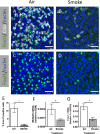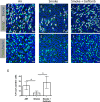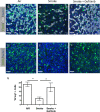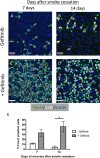Gefitinib, an EGFR Tyrosine Kinase inhibitor, Prevents Smoke-Mediated Ciliated Airway Epithelial Cell Loss and Promotes Their Recovery
- PMID: 27532261
- PMCID: PMC4988636
- DOI: 10.1371/journal.pone.0160216
Gefitinib, an EGFR Tyrosine Kinase inhibitor, Prevents Smoke-Mediated Ciliated Airway Epithelial Cell Loss and Promotes Their Recovery
Abstract
Cigarette smoke exposure is a major health hazard. Ciliated cells in the epithelium of the airway play a critical role in protection against the noxious effects of inhaled cigarette smoke. Ciliated cell numbers are reduced in smokers which weakens host defense and leads to disease. The mechanisms for the loss of ciliated cells are not well understood. The effects of whole cigarette smoke exposure on human airway ciliated ciliated cells were examined using in vitro cultures of normal human bronchial epithelial cells and a Vitrocell® VC 10® Smoking Robot. These experiments showed that whole cigarette smoke causes the loss of differentiated ciliated cells and inhibits differentiation of ciliated cells from undifferentiated basal cells. Furthermore, treatment with the epidermal growth factor receptor (EGFR) tyrosine kinase inhibitor, Gefitinib, during smoke exposure prevents ciliated cell loss and promotes ciliated cell differentiation from basal cells. Finally, restoration of ciliated cells was inhibited after smoke exposure was ceased but was enhanced by Gefitinib treatment. These data suggest that inhibition of EGFR activity may provide therapeutic benefit for treating smoke related diseases.
Conflict of interest statement
Figures






Similar articles
-
Ciliatoxicity in human primary bronchiolar epithelial cells after repeated exposure at the air-liquid interface with native mainstream smoke of K3R4F cigarettes with and without charcoal filter.Exp Toxicol Pathol. 2015 Jul-Aug;67(7-8):407-11. doi: 10.1016/j.etp.2015.04.006. Epub 2015 May 8. Exp Toxicol Pathol. 2015. PMID: 25963947
-
Caveolin-1 aggravates cigarette smoke extract-induced MUC5AC secretion in human airway epithelial cells.Int J Mol Med. 2015 May;35(5):1435-42. doi: 10.3892/ijmm.2015.2133. Epub 2015 Mar 11. Int J Mol Med. 2015. PMID: 25776934
-
Bronchial airway epithelial cell damage following exposure to cigarette smoke includes disassembly of tight junction components mediated by the extracellular signal-regulated kinase 1/2 pathway.Chest. 2009 Jun;135(6):1502-1512. doi: 10.1378/chest.08-1780. Epub 2009 May 15. Chest. 2009. PMID: 19447922
-
Regulation of cigarette smoke-mediated mucin expression by hypoxia-inducible factor-1α via epidermal growth factor receptor-mediated signaling pathways.J Appl Toxicol. 2012 Apr;32(4):282-92. doi: 10.1002/jat.1679. Epub 2011 May 4. J Appl Toxicol. 2012. PMID: 21544845
-
Molecular processes that drive cigarette smoke-induced epithelial cell fate of the lung.Am J Respir Cell Mol Biol. 2014 Mar;50(3):471-82. doi: 10.1165/rcmb.2013-0348TR. Am J Respir Cell Mol Biol. 2014. PMID: 24111585 Free PMC article. Review.
Cited by
-
Cilia interactome with predicted protein-protein interactions reveals connections to Alzheimer's disease, aging and other neuropsychiatric processes.Sci Rep. 2020 Sep 24;10(1):15629. doi: 10.1038/s41598-020-72024-4. Sci Rep. 2020. PMID: 32973177 Free PMC article.
-
Neddylation inhibitor MLN4924 suppresses cilia formation by modulating AKT1.Protein Cell. 2019 Oct;10(10):726-744. doi: 10.1007/s13238-019-0614-3. Epub 2019 Mar 9. Protein Cell. 2019. PMID: 30850948 Free PMC article.
-
Multi-endpoint analysis of human 3D airway epithelium following repeated exposure to whole electronic vapor product aerosol or cigarette smoke.Curr Res Toxicol. 2021 Feb 20;2:99-115. doi: 10.1016/j.crtox.2021.02.004. eCollection 2021. Curr Res Toxicol. 2021. PMID: 34345855 Free PMC article.
-
Patterns of Ciliation and Ciliary Signaling in Cancer.Rev Physiol Biochem Pharmacol. 2023;185:87-105. doi: 10.1007/112_2020_36. Rev Physiol Biochem Pharmacol. 2023. PMID: 32761455 Free PMC article. Review.
-
Respiratory Viral and Bacterial Exacerbations of COPD-The Role of the Airway Epithelium.Cells. 2022 Apr 22;11(9):1416. doi: 10.3390/cells11091416. Cells. 2022. PMID: 35563722 Free PMC article. Review.
References
-
- Services USDoHaH. The Health Consequences of Smoking-50 Years of Progress: A Report of the Surgeon General. Atlanta (GA); 2014.
-
- Wanner A, Salathe M, O'Riordan TG. Mucociliary clearance in the airways. Am J Respir Crit Care Med 1996; 154: 1868–1902. - PubMed
-
- Auerbach O, Stout AP, Hammond EC, Garfinkel L. Changes in bronchial epithelium in relation to cigarette smoking and in relation to lung cancer. N Engl J Med 1961; 265: 253–267. - PubMed
-
- Takeyama K, Jung B, Shim JJ, Burgel PR, Dao-Pick T, Ueki IF, et al. Activation of epidermal growth factor receptors is responsible for mucin synthesis induced by cigarette smoke. Am J Physiol Lung Cell Mol Physiol 2001; 280: L165–172. - PubMed
MeSH terms
Substances
LinkOut - more resources
Full Text Sources
Other Literature Sources
Research Materials
Miscellaneous

